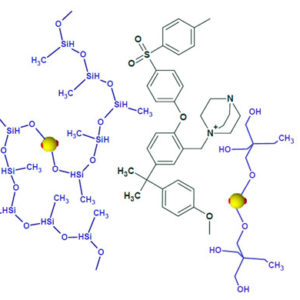Abstract
Composite anion exchange membranes based on polysulfone with grafted 1,4-diazabicyclo[2.2.2]octane (DABCO) and surface functionalized TiO2 nanoparticles were prepared and characterized. Tri(hydroxymethyl)propane (TMP) was used for hydrophilic and polymethyl-hydrosiloxane (PMHS) for hydrophobic surface functionalization. Thermal analysis (TGA and DSC) showed water loss, the loss of quaternary ammonium groups around 300 °C and the backbone decomposition above 400 °C starting from the quaternary carbon. The decompositions were confirmed by temperature-dependent FTIR spectroscopy. The thermomechanical study (DMA) showed a secondary relaxation, probably due to DABCO side groups motions, around 130 °C followed by the glass transition around 250 °C and by a partial crystallization of the polymer, which is also observed by DSC. The increase of storage modulus observed for the composites is consistent with their reduced hydration, which is confirmed by water uptake measurements. Atomic Force Microscopy observations show a more homogeneous dispersion of hydrophobic TiO2 nanoparticles, which are also well embedded in the polymer, whereas agglomeration is evident for hydrophilic surface treatment. The contact angle with water decreases strongly in composites with TMP-TiO2. The ionic conductivity is higher for PMHS-TiO2, probably related to the more homogeneous filler distribution with lower agglomeration.
Illustrations
Details
Published on: International Journal of Hydrogen Energy 2017, 42, 19178-19189
Authors: Z. Derbali, A. Fahs, J.-F. Chailan, I.V. Ferrari, M.L. Di Vona, P. Knauth
